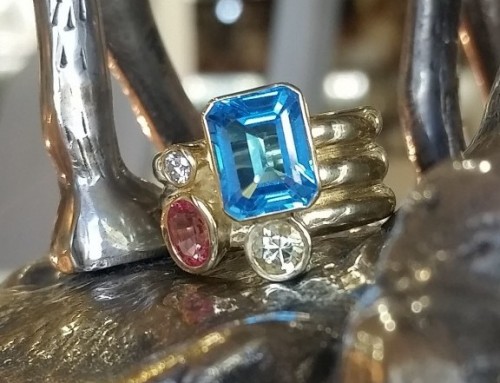Periods of Estate Jewelry
Estate jewelry may come from any time period, however the most popular are Georgian, Early Victorian, Mid-Victorian, Late Victorian, Arts and Crafts Era, Edwardian, Art Nouveau, Art Deco, Retro, and Art Organique.
Georgian Jewelry (1714–1837) – Georgian-era jewelry is fairly hard to come by as much of it has been dismantled over the years. Therefore, it represents some of the most sought-after estate jewelry.
Early Victorian, romantic jewelry (1837–1855) – Early Victorian-era jewelry also featured nature-inspired designs, similar to jewelry of the Georgian era. Frequently, these designs were delicately and intricately etched into gold. Lockets and brooches were popular in daytime jewelry during the early Victorian era, whereas colored gemstones and diamonds were worn during the evening.
Mid-Victorian, grand jewelry (1856–1880) – Because the Grand or Mid-Victorian era corresponded with the death of Queen Victoria’s husband, many jewelry pieces have solemn, somber designs. Known as mourning jewelry, the pieces feature heavy, dark stones. Jet, onyx, amethyst, and garnet are frequently found in jewelry from this period. Compared to previous periods, Mid-Victorian-era jewelry features highly creative, colorful designs using shells, mosaics and gemstones.
Late Victorian, aesthetic jewelry (1885–1900) – During the Late Victorian or Aesthetic period, jewelers used diamonds and feminine, bright gemstones such as sapphire, peridot, and spinel. Star and crescent designs as well as elaborate hat pins were also popular. Some scholars believe the aesthetic era began sooner, in 1875, and ended as early as 1890.
Arts and Crafts Jewelry (1894–1923) – Due to the Industrial Revolution, many jewelry designers rebelled during the Arts and Crafts movement, returning to intricate jewelry designs and handmade craftsmanship. It was common for jewelry of this era to be simple in pattern and made of colorful, uncut stones.
Art Nouveau jewelry (1895–1915) – Art Nouveau jewelry features natural designs such as flowers and butterflies and were generally considered “romantic”. This style was popular from about 1895 until World War I. The style actually began around 1875 in Paris, and its influence went throughout the western world. The style died out by the end of World War I but has often been revived. Art Nouveau jewelry follows curves and naturalistic designs, especially depicting long-haired, sensual women, sometimes turning into bird-like or flower-like forms.
Art Nouveau vintage jewelry is still a source of inspiration and popular among many collectors; in particular collectors of the work of Rene Jules Lalique and Louis Comfort Tiffany.
Edwardian jewelry (1901–1915) – The Edwardian period began with the death of Queen Victoria, when her son Edward became King. During this period, many of the Edwardian-designed pieces incorporated more expensive gems such as diamonds, emeralds, and rubies in elaborate designs.
Art Deco jewelry (1915–1935) – A stylized design which was named after the 1925 International Exhibition of Modern Decorative and Industrial Arts, held in Paris, France. Much Art Deco design was a transition from the earlier Art Nouveau and, as with the Art Nouveau epoch, was inspired by the art of the indigenous peoples of the Americas and by ancient Egyptian, Greek and Roman architecture. Art Deco jewelry motifs are characterized by geometric designs, diverse combinations of color, and abstract patterns. In 1922, the opening of Tutankhamen’s tomb in Egypt inspired another Egyptian revival. Influences from cubism as well as African, oriental, Persian, Islamic, and Jugendstil designs were common in Art Deco jewelry. The early 1920s’ interest in Cubism and Dadaism as a new art form greatly influenced the Art Deco period. Additionally, the mysteries of the pyramids and a continuing revival of astrological studies lent themselves to Art Deco designs, which in turn were incorporated in the Art Moderne period following 1930.
Art Deco style in other European countries was largely derivative, like the Italian G. Ravasco’s diamond-studded geometric creations or Theodor Fahmer’s later jewels. Some London jeweler, like Asprey and Mappin & Webb, produced Art Deco-style confections, but these are largely unsigned, so the designers are unknown. Some British design jewelers, however—like Sibyl Dunlop, Harold Stabler and H. G. Murphy, known primarily for their Arts and Crafts pieces—produced decidedly modern jewelry.
George Jensen’s firm in Copenhagen continued to produce silver jewelry in the Art Deco era, adding sharp geometric forms to its repertoire of stylized motifs; these in turn were imitated by a host of European jewelers.
Art-deco jewelry is one of the most sought-after jewelry categories, as demonstrated by auction results.
Retro jewelery(1945–1960) – Inspired by Hollywood, Retro jewelry is colorful, bold and elaborate. Most commonly worn were large cocktail rings, bracelets, watches, necklaces and charm bracelets.
Art Organique jewelry (20th century – ) – This style comes in the form of nature-inspired and more abstract geometric jewelry design inspired by the sciences, especially ecology, structural biology, and mathematics. Art Organique is characterized by continuity, flow, and movement as expressed in distinctly three-dimensional forms. According to the philosophy of the style, art should reflect man and nature. The goal is to understand nature’s underlying ‘spirit’ rather than merely copying natural form.




